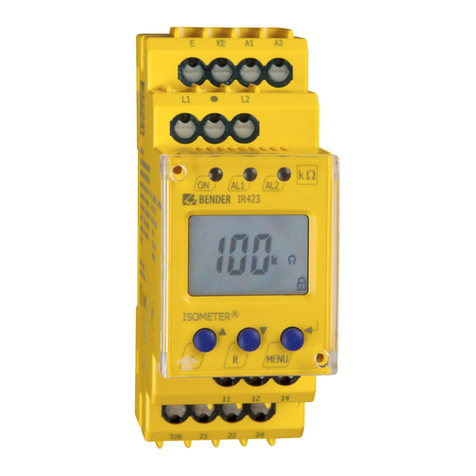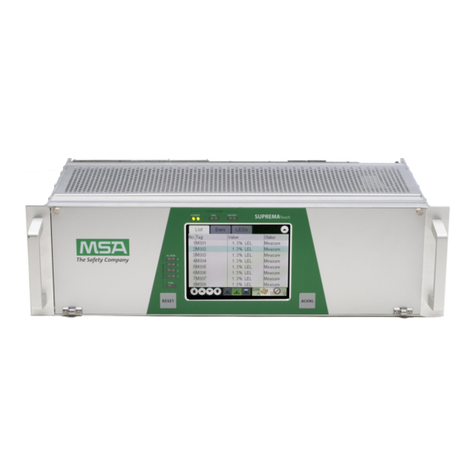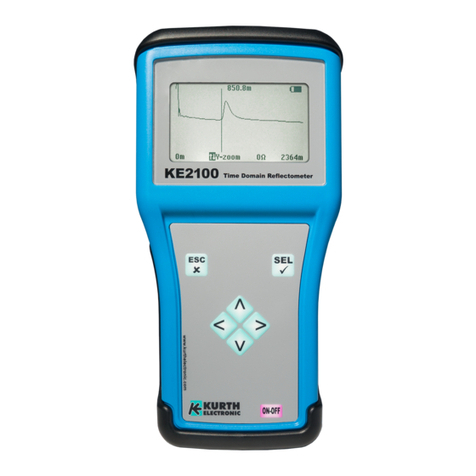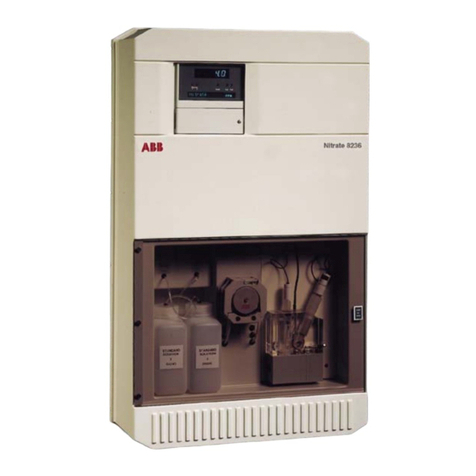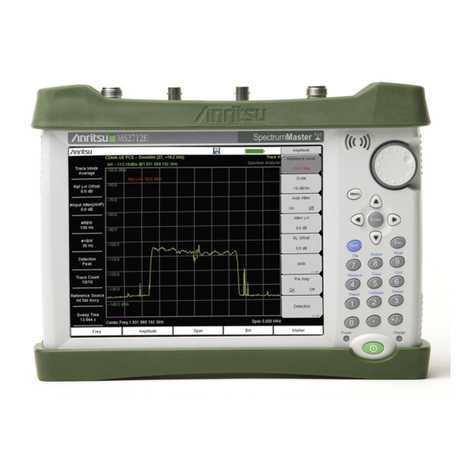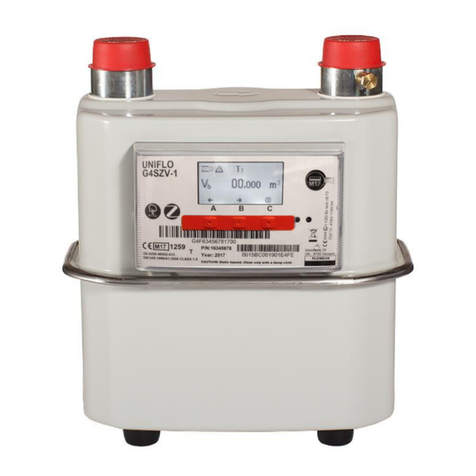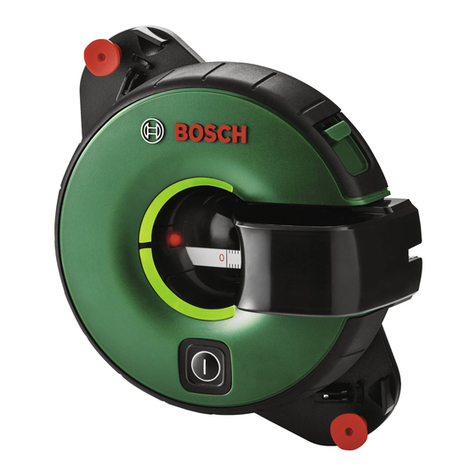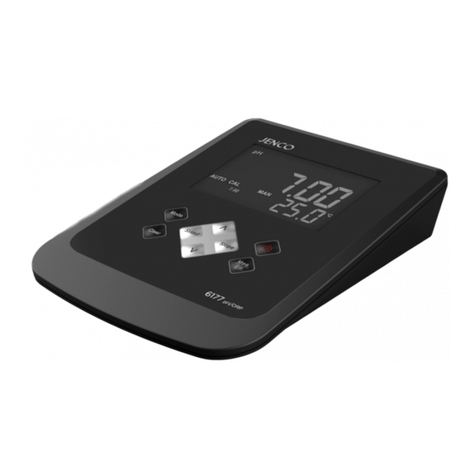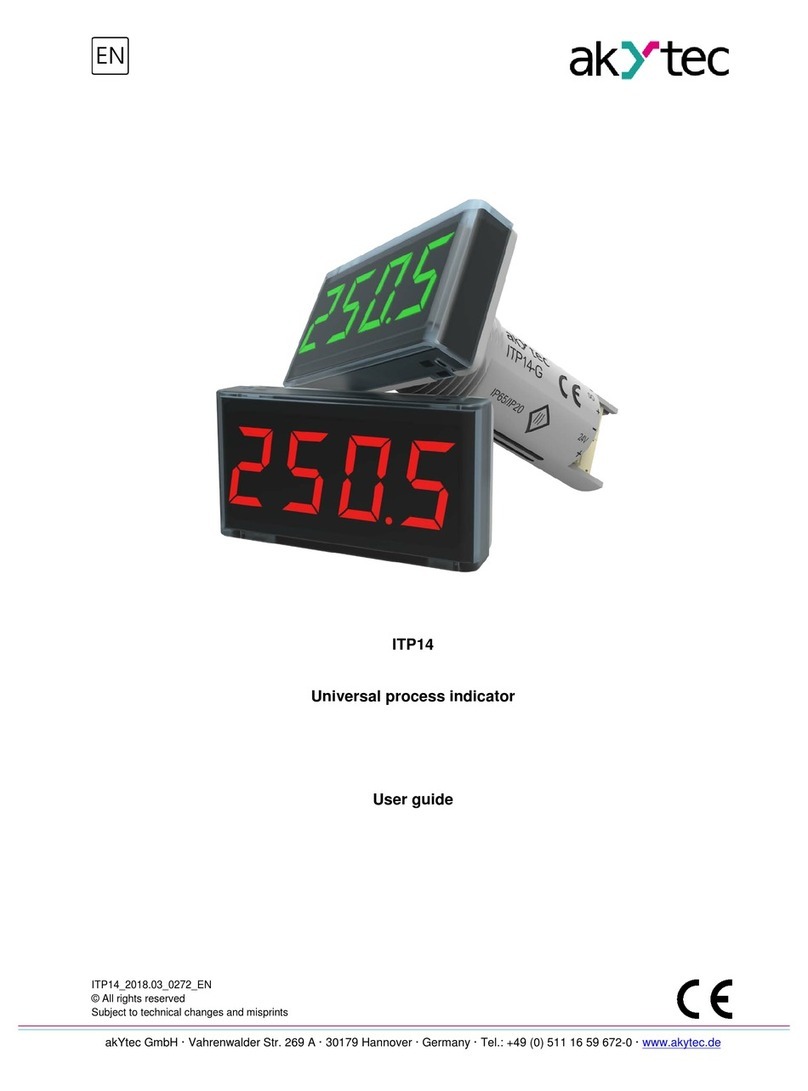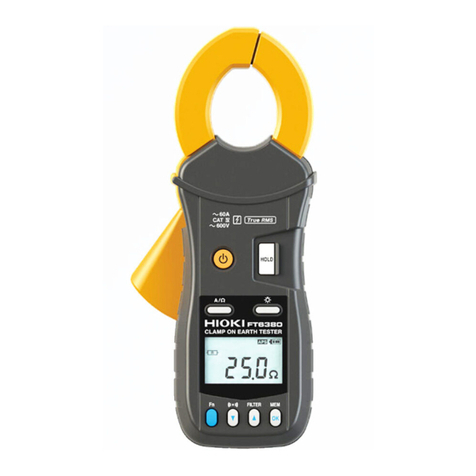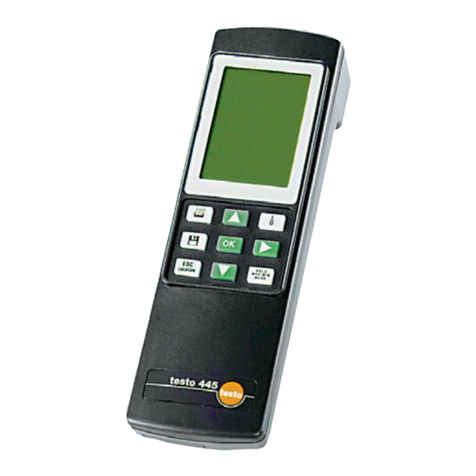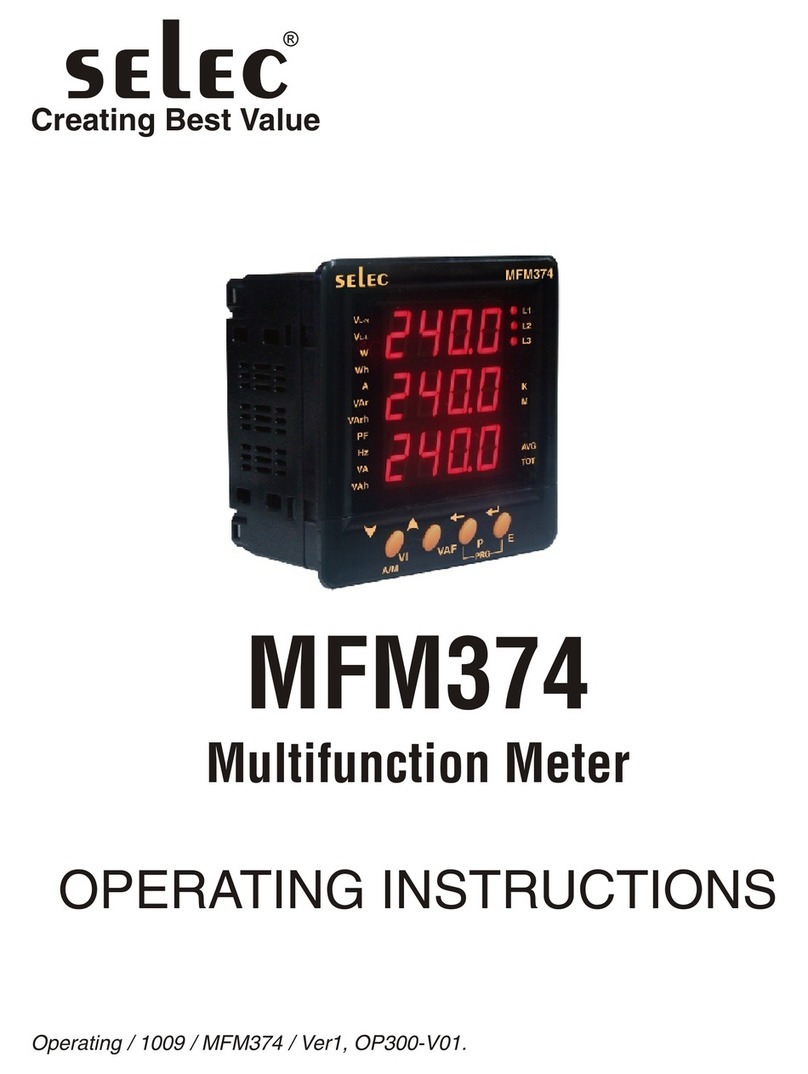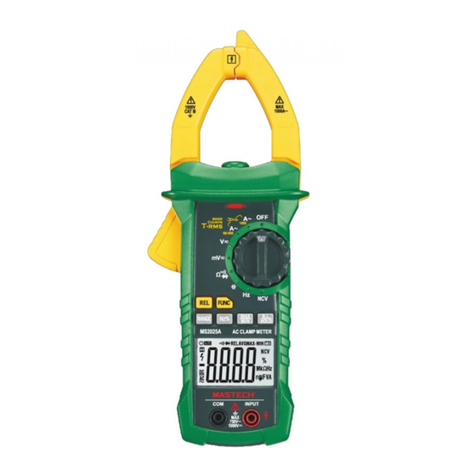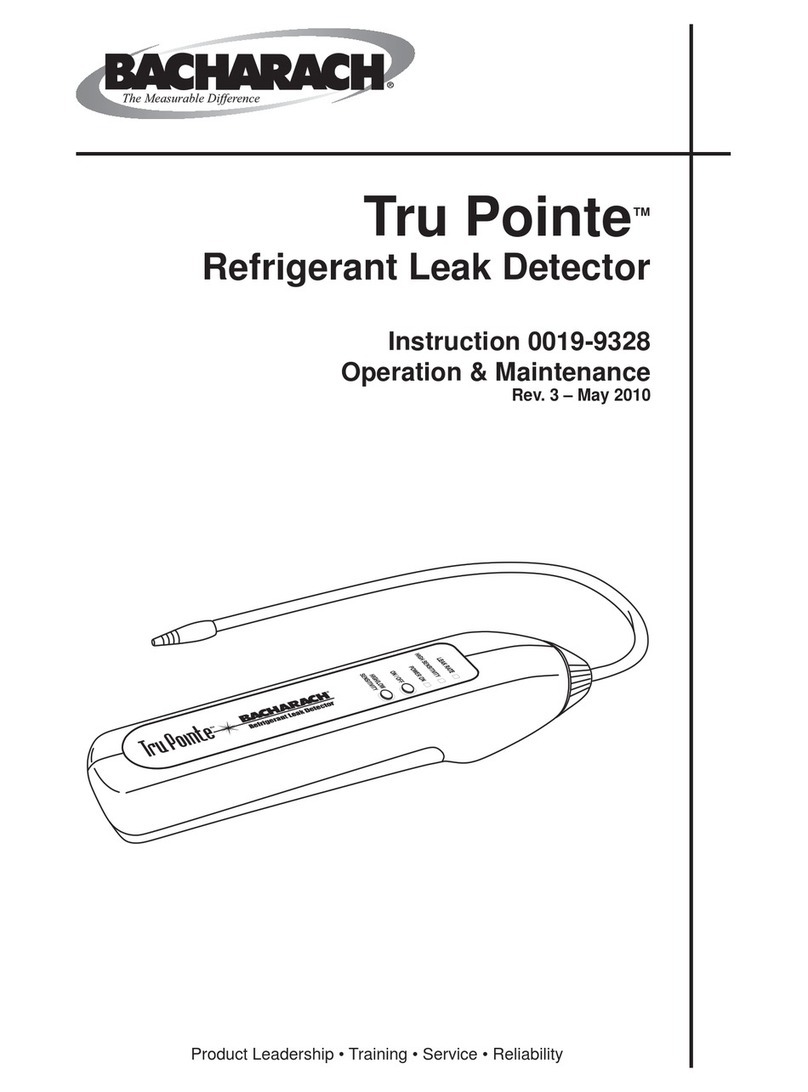BELITE ELECTRONICS RADIANT RFGA-022C User manual

BELITE ELECTRONICS is a Division of BELITE AIRCRAFT - Wichita, Kansas www.beliteaircraft.com E: [email protected] T: 316-253-6746
RADIANT Fuel gauge
Item#: RFGA
Specications, Installation and
Operation Instructions for the
Belite RADIANT Fuel Gauge
LAST UPDATED: May 2017
DISCLAIMER:
Products from Belite Electronics are not
designed to be used in applications where
their failure would endanger safe ight or
human life in any way. They are intended
solely for use in VFR conditions. They are
not certied to meet any Technical Standard
Order, and are not produced under a Parts
Manufacturing Authority (TSO / PMA).
As a result, they are suitable only for use
in experimental and ultralight aircraft,
and in Light Sport Aircraft, if meeting the
requirements of the respective manufacture.
WARRANTY:
Your new Belite Avionics instrument carries
a one year warranty. Please contact us at
info@beliteaircraft.com should your product
need warranty service. International warranty
service will be charged $50.00US for repairs,
which includes return shipping after repair.
Payment must be received before service
begins.
RETURN/REFUND INFORMATION:
Must be returned in new, resalable condition
within 14 days
CONTACT INFORMATION:
E: info@beliteaircraft.com
T: 316-253-6746
Belite Enterprises LLC
8610 E. 34th St. N, #1
Wichita, KS 67226
FUEL CONTROL SYSTEMS
A New Generation of Digital Avionics
T: 316-253-6746
www.beliteaircraft.com
The Belite RADIANT Fuel Gauge
is designed to provide fuel level
and historical usage informa-
tion to the pilot in a single, small
lightweight enclosure. The unit
is not TSO’d or PMA’d. Use only in
appropriate aircraft as a backup
to certied instruments in VFR
conditions.
As opposed to traditional needle
‘steam gauges’, which often
work poorly and provide only a
single dimension into the fuel
use situation, this new RADIANT
gauge provides current fuel
levels and fuel use trends using
an unusually brilliant, full color
LCD screen.
These fuel gauges also provide
predictive time to empty. This
calculation is based on the last
six minutes of fuel usage, and
displays a value whenever the
calculated time is less than 99
minutes, and fuel is still in the
tank. The value is provided
independently for each tank.
And if you’d like your tanks
designated as something other
than LEFT or RIGHT, you can
congure that as well. Main,
Left, Right, Header, Aux.. are all
available labeling options.
If you are running with just
one tank, you may turn o the
second half of the display.
Another big plus is the ability
to use any kind of automotive
fuel sender. You can tell the unit
if the ohms runs big to small,
or small to big. (Automotive
senders are often reversed from
the aircraft standard.)
Product References
Item#: RFGA-022C:
CAPACITIVE or FIVE VOLT
SCALE INPUT with SINGLE or
DUAL TANKS
Item#: RFGA-022R:
RESISTIVE OR FLOAT INPUT
with SINGLE or DUAL TANKS
Item#: RFGA-022L:
LIQUID LEVEL FUEL PROBE
INPUT with SINGLE or DUAL
TANKS
This document also refers to
other Belite products:
Item#: FPS-010:
LIQUID LEVEL FUEL PROBE
WITH COMPUTER AND FIVE
POINT CALIBRATION AND
1/4NPT THREAD
Item#: FPS-018:
LIQUID LEVEL FUEL PROBE
WITH COMPUTER AND FIVE
POINT CALIBRATION AND
1/8NPT THREAD
Item#: FPS-110:
LIQUID LEVEL FUEL PROBE
WITHOUT COMPUTER WITH
1/4 NPT THREAD
Item#: FPS-118:
LIQUID LEVEL FUEL PROBE
WITHOUT COMPUTER WITH
1/8 NPT THREAD

FUEL CONTROL SYSTEMS
Radiant fuel Gauge page 2
BELITE ELECTRONICS is a Division of BELITE AIRCRAFT - Wichita, Kansas www.beliteaircraft.com E: [email protected] T: 316-253-6746
FEATURES
Calculates time to empty for each tank
User selects appropriate tank labeling
Works with automotive fuel senders or aircraft fuel senders
Brilliant daylight readable LCD display
Provides current fuel level in bar height form and percentage form
Shows 15 minute history of fuel level, so the pilot can see the trend instantly
Supports one or two tanks
Display is“sunglass friendly”-- bright; readable with polarized glasses
Works with capacitive probes
Works with resistive probes
Works with pressure (mass or weight) sensor probes
Settable for high and low fuel level on either tank, to exactly match sensors & probes
Also provides continuous system voltage display
Works between -20C and +60C
Weighs 1.6 ounces (50 grams)
SPECIFICATIONS
Requires 10 to 32 volts @ 135ma @ full screen brightness. When screen is dim, power
consumption of unit is approximately 35ma.
Screen is non-polarized color LCD display TFT Active Matrix with resolution of 240 x 320 pixels
across a 2.4”display. Some corner and side areas of the display are not visible due to enclosure
requirements.
Unit operating temperature between -20 and +60C, including LCD screen.
Accuracy of the unit is 1% or better. This means that an input of 0 volts will provide an indication
of 0%, assuming correct calibration and programming. This also means that an input of 4.0 volts
(80% for a standard capacitive probe of 5V range) will provide an indication of 3.96 to 4.04 volts,
or 79 to 81% displayed.
Dimensions for screen cutout are shown below, see Figure 1.
Unit dimensions are 2.35”square with a thickness of 0.75”, not including connector height.
Screen display mode is transmissive, normally deep black. This means that in the absence of
backlighting, you will not be able to read the screen.
Screen contrast ratio is minimum of 640.
Screen luminance is minimum of 450 cd/M2at full brightness.
Screen viewing angle is up to 80 degrees.
Two tactile switch inputs are provided for programming and mode changes.
Accepts input from any sender with an approximate range of 0 to 5 volts. (Model RFGA-022C). This
includes almost all capacitive probes, even those with ranges of 0 to 4 volts, or 0.5 to 4.5 volts.
Accepts input from any oat sender, with either direction of ohms (Model RFGA-022C.) Typical
input ranges which are acceptable include 0 to 90 ohms, 240 to 33 ohms, or just about anything
with a total max ohms of 500 or less. We have another model if your resistive sender is greater
than 500 ohms; ask us.
Fuel level information is provided for two tanks. Single tank mode may also be selected.

FUEL CONTROL SYSTEMS
BELITE ELECTRONICS is a Division of BELITE AIRCRAFT - Wichita, Kansas www.beliteaircraft.com E: [email protected] T: 316-253-6746
radiant fuel GAUGE page 3
SPECIFICATIONS CONT.
Fuel level information is simultaneously displayed as bar graph and numerical display, 0 to 100%.
Fuel level information is provided historically for the last 15 minutes of usage.
Current fuel level information is dampened using a hardware circuit and software algorithm with
a maximum period of 2 ½ minutes. This means that fuel sloshing indications on the gauge are
diminished or eliminated. This also means that if you have a fuel rupture, it may take up to the
indicated time for the fuel gauge to correctly reect the real fuel level.
Voltage level information is provided for ship power. Guaranteed unit operating range is 10 to 32
volts.
Accepts direct input from Belite fuel level liquid sensors. (Model RFGA-022L)
Two connectors are provided for attaching power, probes, and dimming input.
FIVE PIN CONNECTOR:
• GROUND, LEFT INPUT, RIGHT INPUT, POWER INPUT, BACKLIGHT DIMMER
• WIRE COLORS: BLACK, ORANGE, ORANGE, RED, YELLOW
SEVEN PIN CONNECTOR:
• GROUND, LEFT INPUT, RIGHT INPUT, +5V REGULATED POWER OUTPUT, DNC x 3 (DO NOT
CONNECT x 3)
• WIRE COLORS: BLACK, none, none, RED, none, none, none
• WARNING: DO NOT ATTACH ANY EXTERNAL POWER INPUT TO THE +5V OUTPUT on the seven
pin connector. DOING SO WILL DAMAGE OR DESTROY YOUR UNIT.
APPLICATIONS
May be used to display fuel level and trend in any experimental, ultralight, or LSA aircraft (with
manufacturer approval).
NON-TSO’d; non-PMA’d.
Figure 1: 2.25” Main Cutout. Four 0.170” mounting
holes are on 2.625”diameter circle. Inner circle is 2.25”.
INSTALLATION
Fits any standard 2.25”mounting hole.
Use only the screws provided. DO NOT DRILL OUT HOLES
FOR LARGER SCREWS. Doing so will void warranty!
Requires a voltage source between 10 and 32 volts.
Power draw is 135 milliamps (backlight full on).
Use with an external avionics power switch.
Use with an external dimmer potentiometer (supplied).

FUEL CONTROL SYSTEMS
BELITE ELECTRONICS is a Division of BELITE AIRCRAFT - Wichita, Kansas www.beliteaircraft.com E: [email protected] T: 316-253-6746
Radiant Fuel Gauge page 4
INSTALLATION DETAILS
The rear main external electrical connector has ve wires: ground, left tank input, right tank
input, power, and backlight input. (The colors are black, orange, orange, red and yellow, respec-
tively.) Prior to installation in aircraft, the power connector should be snipped o and discarded.
The ground must be connected to avionics (system) ground. The power must be connected to
a voltage source between 10 and 32 volts. The backlight input must be connected to a variable
voltage source, providing between 0 and 5 volts. The level on this input is digitally sampled by a
microprocessor inside the gauge, so there is no signicant current draw from this variable input.
An external potentiometer is supplied and may be installed anywhere in your panel.
NOTE: DO NOT DRILL OUT THE CORNER HOLES. THIS WILL DAMAGE THE LCD MODULE AND VOID
YOUR WARRANTY!
SWITCHES AND INDICATORS
The main color LCD screen provides continuous graphic information to the pilot.
Two tactile switches allow switching between the main screen and the programming screen,
also allowing setting“Low” and “Hi” settings for each tank.
Three pseudo LED outputs provide status of: System Voltage, Programming Integrity, and
Temperature.
FUNCTIONALITY
This gauge provides real time fuel level feedback for one or two fuel tanks using a bar graph and
a numeric percentage indicator.
The gauge also provides a 15 minute history of fuel levels for one or two tanks via a series of
easy to understand bar graphs.
Current voltage is displayed numerically.
If meaningful, current time to empty is displayed independently for both tanks.
User may select labeling or either tank.
User may turn o right tank display (for single tank applications.)
The gauge is compatible with capacitive probes, or any probe providing an approximate input
between 0 and 5 volts. This also includes probes with ranges of 0.5 to 4.5 volts, also 0 to 4 volts.
Any similar probe providing any DC voltage range similar to these will work without issue.
Also available is a version of the gauge which is compatible with common resistive senders,
which are typically installed in fuel tanks with oats. Compatible resistance ranges are 0
(minimum) to 500 ohms (maximum). An example of a compatible resistance range is 33 to 240
ohms. Another example of a common range is 0 to 90 ohms.
The gauge is also available in a version which is directly compatible with Belite’s fuel tank
pressure transducers, meaning that it will directly attach to the transducer without requiring an
intermediary fuel probe computer.
The gauge is only as accurate as the probe (and calibration thereof, along with variations in ow
rates, tank sizes, temperatures, settling time, and other factors.)
When utilized as a voltmeter, the gauge has an accuracy of 1%. This means that an input from a
probe of 4.00 volts would be displayed within the range of 3.96 and 4.04 volts.

OPERATION
Turn the unit on. A screen will display containing your
model number and type of input expected. The screen
will also show our company name,‘Belite’, along with an
indication as to whether the unit is“locked” or “unlocked”.
See Figure 2.
If the display is dim, turn up the brightness using the
included potentiometer.
While booting, the rst screen will also show“1 vs 2”tanks
over the right button. Depressing and holding this during
the boot process will ip the unit to single tank mode, and
vice-versa.
While booting, the rst screen will also show“Label”over
the left button. Depressing and holding this during the boot process will allow the user to select
labels. Tap the switches to roll through selections. Hold either button down for several seconds
to lock in changes and advance to a normal instrument boot.
While booting, IF YOU HOLD BOTH BUTTONS DOWN FOR FIVE SECONDS OR MORE, the unit will
shift from Positive to Negative direction on the sender type. This is reected on the right hand
display as an R+/R- indication, or similar. This allows using senders with reversed polarities.
We’ll come back to the meaning of “LOCKED” later in this document.
After ve seconds, the unit will automatically advance to the main display screen. The screen will
look similar to the image to the right, Figure 3.
At this point, let’s describe the standard attributes of the main display screen.
On the left side are three indicator blocks, which
are labeled“V”, “P” and “T”. They stand for Voltage,
Programming, and Temperature.
The “V”provides system voltage status. Green is indicated
for any ship power voltage between 10 and 32 volts; the
indicator block turns red outside of this range.
The “P” indicates that the unit has rational programming
parameters set; an example of a rational value would
be a full tank set value of 4.95 volts and an empty
value of 0.05 volts. An irrational value would be when
the full value is equal to or less than the empty value,
simply indicating a programming setup error by the user.
“P” is green if good programming and red if bad. If it is red,
resolve before ight, as the display will not show any information!
The “T” indicates that the internal microprocessor and display are within acceptable temperature
boundaries. If the unit is too hot, the indicator block will turn red. If the unit is too cold, the
indicator block will turn blue. (In extreme cold, below -20C, the LCD screen may not function at all,
and you may not be able to see anything.)
The left and right tanks are shown with bar graphs.
FUEL CONTROL SYSTEMS
BELITE ELECTRONICS is a Division of BELITE AIRCRAFT - Wichita, Kansas www.beliteaircraft.com E: [email protected] T: 316-253-6746
radiant fuel gAUge page 5
Figure 3: Right tank shows ow rate of
21 minutes remaining.
Figure 2: Fuel Gauge Startup Screen
showing“LOCKED.”

FUEL CONTROL SYSTEMSFUEL CONTROL SYSTEMS
Radiant fuel Gauge page 6
BELITE ELECTRONICS is a Division of BELITE AIRCRAFT - Wichita, Kansas www.beliteaircraft.com E: [email protected] T: 316-253-6746
OPERATION CONT.
The right side of the screen contains predictive times to empty (in minutes, with “L” and “R” for left
and right tank).
The right side also shows whether you are set up in 1Tank or 2Tank mode. (‘1Ta’or ‘2Ta’).
Just above the voltage display is an indication of the type of the unit, along with the probe polarity.
For aircraft resistive probes, you would see ‘R-’. For auto probes, you would see‘R+’. For Capacitive
probes, you would see‘C+’. If you ever would use a reversed capacitive probe, it would be‘C-’.
Now, let’s look at a display with some actual fuel information in it. See Figure 4 at right.
Let’s discuss what we are seeing. Each bar represents one min-
ute of information, and a total of 15 bars are displayed for each
tank, representing current condition and 14 minutes of history.
In the example, the left tank is full, while the right tank has 89%
remaining and is showing a calculated time of 53 minutes to
empty.
The colors associated with the fuel bar graphs and current
situation arrows correspond to the current fuel percentages.
Green – 100% to 50%
Yellow – 50% to 25%
Red – 25% to 0%
BELITE ELECTRONICS is a Division of BELITE AIRCRAFT - Wichita, Kansas www.beliteaircraft.com E: [email protected] T: 316-253-6746
Figure 4: Left tank full. Right tank at 89%.
System volts is 17.4.
PROGRAMMING
Now let’s learn how to program the unit to match your senders. You only have to do this once in the
lifetime of the unit!
WE STRONGLY RECOMMEND“PLAYING”WITH
YOUR UNIT BEFORE INSTALLATION IN THE
AIRCRAFT. THIS MAY BE DONE WITH A FRESH
9 VOLT LITHIUM BATTERY. BECOME FAMILIAR
WITH THE UNIT BEFORE YOU BECOME FRUS-
TRATED WITH THE INSTALLATION AND PRO-
GRAMMING.
If your unit is LOCKED, it is impossible to change
the programming values! The locking feature is
included so that pilots will not errantly repro-
gram their units while in ight.
If your unit is LOCKED, it displayed the message
“LOCKED” on the startup screen when it powered up. Recycle the power on your unit and look at the
startup screen. It was shown earlier in this document. See Figure 2, far above.
If your unit is LOCKED, it is necessary to unlock it rst before programming. To do that, power on the
unit, observe the startup screen, and allow it to automatically switch to the main screen. When the
main screen is displayed, you may now switch to UNLOCKED mode. This is done by simultaneously
depressing and holding down both switches. The unit will clear and reboot (you may stop holding
the switches down anytime thereafter), and you will now see a new startup screen, which will look
like Figure 5.
Figure 5: Startup screen showing“UNLOCKED”

FUEL CONTROL SYSTEMS
radiant fuel gAUge page 7
BELITE ELECTRONICS is a Division of BELITE AIRCRAFT - Wichita, Kansas www.beliteaircraft.com E: [email protected] T: 316-253-6746
Thereafter, approximately ve seconds later, the unit will progress to the main screen.
The EMPTY and FULL positions for each of the LEFT and RIGHT tanks are programmed independent-
ly. Let’s start by programming the LEFT tank. (The unit doesn’t care if you start with the LEFT or RIGHT
tank, or the EMPTY OR FULL setting. You can do it
in any order you want.)
Depress the LEFT switch for one second, then re-
lease the switch. The unit will now display a screen
similar to Figure 6.
Let’s carefully examine this screen, as shown in
Figure 6. At the top, in ridiculously tiny letters, are
the code version and the serial number.
LEFT is shown in large letters. The HI TANK number
in red indicates that the unit currently is set so that
4.96 volts is the maximum voltage expected from
the probe sender unit. The LO TANK number in red
indicates that 0.03 volts is the minimum voltage expected from the probe sender unit.
The INPUT numbers of 0.01 and 4.45 volts are the actual values being received from the LEFT and
RIGHT probe senders. These raw voltage levels will always reect exactly what the fuel gauge unit is
receiving from the probes. We provide both tanks all the time on this screen, even though we pro-
gram only one side at a time. In this example, the LEFT sender is providing a real time reading of 0.01
volts (empty) while the RIGHT sender is providing a real time reading of 4.45 volts (about 80% full.)
(Later on, we’ll see how we can use this useful real time information in ight.)
For programming the unit, it’s usually best to start with an empty tank, on the ground, in a ight
neutral position. That’s especially important for taildragger aircraft which sit in a non-ight position
when on the ground.
As for programming, all we have to do is press the SET LO button for three seconds and the level will be
memorized. After this, you’ll see that the LO TANK number changes to match the current sender input.
Fill the tank to full, wait three minutes, and repeat the process by pressing the SET HI button for three
seconds. The HI TANK number will change to match the current sender input.
You can repeat this process indenitely, without
ever leaving the screen.
To leave screen, briey touch either button for less
than one second. The unit will revert to main screen.
While on the main screen, you can depress the
RIGHT switch for one second, and it will take you
to the RIGHT screen, an example which looks like
Figure 7:
The process of programming the screen is identical
to the LEFT process previously described.
When you are done programming, briey touching either button reverts to the main screen.
After programming is complete, you must LOCK the unit again. This is done exactly the same way as
Figure 6: LEFT programming screen
PROGRAMMING CONT.
Figure 7: RIGHT programming screen.

FUEL CONTROL SYSTEMS
BELITE ELECTRONICS is a Division of BELITE AIRCRAFT - Wichita, Kansas www.beliteaircraft.com E: [email protected] T: 316-253-6746
UNLOCKing: from the main screen, simultaneously hold both buttons until the unit reboots. The unit
will display the LOCK indication on the boot screen, showing that the unit may not be programmed.
Here are some tips and tricks which will help:
Out of the box, 0 to 5 volt units are preset to a range of 0.01 volts to 5.00 volts. You may not
need to program your unit if you are happy with these values.
When on either the LEFT or RIGHT programming screens, you can revert to factory mode (0.01
to 5.00 volts) by simultaneously holding both buttons down simultaneously. Push them and
hold them down! This ignores the current INPUT and simply resets these values to the factory
mode. Release after three seconds. CAUTION: Not all ve volt senders go down to 0.00 or even
0.01 volts! And not all ve volt senders go up to 5.00 volts!
If you want to start over, just power cycle the unit.
If you want to LOCK or UNLOCK the unit, just power cycle the unit, wait for the main screen, and
depress both buttons. The unit will reboot and show you the new status.
radiant fuel gauge page 8
PROGRAMMING CONT.
INFLIGHT UTILIZATION OF RAW FUEL SENDER INFORMATION
Earlier, we hinted that it is possible to see the
raw fuel sender information while in ight. To
do this, ensure that the unit is LOCKED. From the
main screen, briey touch either button, and
the unit will show the programming screen, as
shown in Figure 8.
Note that the HI TANK and LO TANK values are
not red, they are white. This means that it is im-
possible to change them. Meanwhile, the INPUT
values are showing real time input from the fuel
senders. In our example in Figure 8, they are
0.01 and 4.45 volts respectively for the LEFT and
RIGHT tank. Revert back to the main screen by
briey touching either button. Holding the buttons down for extended periods of time will do
nothing.
Tip:
It doesn’t matter which LEFT or RIGHT screen you go to; the INPUT values from both tanks are
always continuously displayed on both.
Figure 8: Programming screen while locked
RESISTIVE AND LIqUID FUEL PROBE PROGRAMMING NUANCES
Resistive and Liquid Fuel Probe units program in an identical manner, showing volts and allow-
ing settings for HI TANK and LO TANK; also showing INPUT from each tank. The main dierence is
that the voltage ranges will rarely be in a nice, neat voltage range from 0.01 to 5.00 volts.
For example, with Belite’s Liquid Fuel probe sender, the input range is typically 0.50 volts (LO
TANK setting) up to 1.30 volts or higher (HI TANK setting.) The settings for your installation are
completely dependent on the depth of your tank and other factors.
Likewise, resistive or oat probe senders will produce a voltage value which appears to be ir-
regular. This is normal.

CIRCUIT DIAGRAMS
CAPACITIVE INPUT GAUGE (0 to 5V input) [Part # RFGA-022C]
Here is the schematic diagram of a typical installation with capacitive probe senders (Figure 9).
The left of the diagrams shows a master power source, typically +12V. It is switched and fused.
The power goes to both senders and the gauge; the outputs of the senders are connected to the
inputs of the gauge. The dimmer input is connected to the wiper on the included potentiometer.
The seven pin connector provides a ground point and a regulated ve volt power source for utili-
zation with the potentiometer.
FUEL CONTROL SYSTEMS
BELITE ELECTRONICS is a Division of BELITE AIRCRAFT - Wichita, Kansas www.beliteaircraft.com E: [email protected] T: 316-253-6746
radiant fuel gauge page 9
RESISTIVE INPUT GAUGE (0 to 500 ohm)
(Typically 0 to 90 ohm; 30 to 340; etc.) [RFGA-022R]
Here is the schematic diagram (Figure 10) of a typical installation with resistive oat senders.
The left of the diagrams shows a master power source, typically +12V. It is switched and fused.
The power goes to just the gauge; the outputs of the senders are connected to the inputs of the
gauge. The dimmer input is connected to the wiper on the included potentiometer. The seven pin
connector provides a ground point and a regulated ve volt power source for utilization with the
potentiometer.
In order to sense resistance on the resistive oat senders, current is sourced from the gauge to the
resistive oat wipers.
The oat senders must be grounded (with ground common to the gauge) or fuel level will not be
shown. If you have a non-metal aircraft structure, or your aircraft structure is not grounded to the
instrumentation, this will require running a ground wire from your senders back to your instru-
ment gauge.
YELLOW
RED
ORANGE
ORANGE
GND
BLACK
LEFT SENDER
SWITCH
+12V
NC
NC
NC
RED 1K
+5V
PROBE OUT
PROBE OUT
BLACK
GND
BACKLIGHT
DIMMER
7 PIN
CONNECTOR
WHITE
1A
FUSE
Figure 9: capaciTive or 0-5v inpuT
RIGHT SENDER
5 PIN
CONNECTOR

FUEL CONTROL SYSTEMS
BELITE ELECTRONICS is a Division of BELITE AIRCRAFT - Wichita, Kansas www.beliteaircraft.com E: [email protected] T: 316-253-6746
LIqUID SENSOR GAUGE (0.5 to 5V input) [Part # RFGA-022L]
Here is the schematic diagram (Figure 11 on the next page) of a typical installation with mass sen-
sor senders, such as those sold by Belite.
The left of the diagrams shows a master power source, typically +12V. It is switched and fused. The
power goes to the gauge. The 7 pin connector provides a regulated ve volt output, which goes to
the right and left Mass Sensor Probes; the outputs of the probes are connected back to the inputs
of the gauge on the same 7 pin connector. The dimmer input is connected to the wiper on the
included potentiometer. The seven pin connector provides a ground point and a regulated ve volt
power source for utilization with the potentiometer as well.
Compatibility is with any 1.5PSI sensor with 0.5 to 4.5 volt outputs. For low head (low total height of
fuel) installations, these sensors will typically provide 0.5 (empty) to 1.0 (full) volts.
universal led fuel gauge page 10
CIRCUIT DIAGRAMS CONT.
YELLOW
RED
ORANGE
ORANGE
GND
BLACK
LEFT SENDER
SWITCH
+12V
NC
NC
NC
RED 1K
+5V
PROBE OUT
PROBE OUT
BLACK
GND
BACKLIGHT
DIMMER
WHITE
1A
FUSE
Figure 10: FLoaT (reSiSTive) SenDer
RIGHT SENDER
7 PIN
CONNECTOR
5 PIN
CONNECTOR

CIRCUIT DIAGRAMS CONT.
FUEL CONTROL SYSTEMS
BELITE ELECTRONICS is a Division of BELITE AIRCRAFT - Wichita, Kansas www.beliteaircraft.com E: [email protected] T: 316-253-6746
radiant fuel gauge page 11
TROUBLESHOOTING AND SPECIAL TIPS
Here are some things to ponder when things aren’t working right, from basic to advanced. Is the
display turning on? If not, check to make sure that you are providing power and ground.
My screen is too dim…. Turn up the brightness on the potentiometer. If the potentiometer
is disconnected, your display will be very dim.
I’m ying in low light or dusk conditions, and my screen is too bright… Turn the brightness
down on the potentiometer.
My probes do not work…. Do they, or don’t they? Figure it out by attaching a voltmeter to
them, without attaching the display. Figuring this out rst would help us save about 50% of
our troubleshooting time.
Capacitive probes will provide a voltage that varies between 0 and 5 volts from empty
to full. If yours do not, your probes are bad. Capacitive probes often provide a constant
voltage of zero volts if shorted by water, or if inappropriately bent.
Resistive probes will provide a voltage that varies between a high voltage and a low
voltage. If yours do not, your probes are bad. You can also independently check the health
of your resistive probes by disconnecting them (ENTIRELY) from the gauge and by checking
their resistance. They will have a low resistance (for example, 30 ohms) when full; and a
high resistance (for example, 330 ohms) when empty. Other ranges are possible and likely.
There’s no real standard for resistive probes. Resistive probes go bad either by developing
high resistance (probably due to corrosion or wear on the wiper) or by opening (an internal
failure). Installing a new fuel gauge will never solve the problem of a bad resistive probe.
Mass sensor probes provide a voltage out that is linear to the column mass of liquid above
BLACK
LEFT SENDER
SWITCH
+12V
NC
NC
NC
RED 1K
+5V
BLACK
BACKLIGHT
DIMMER
7 PIN
CONNECTOR
WHITE
1A
FUSE
Figure 11: LiQuiD proBe uniT
RIGHT SENDER
5 PIN
CONNECTOR
ORANGE
ORANGE
NC
NC
RED
YELLOW
+5V

FUEL CONTROL SYSTEMS
BELITE ELECTRONICS is a Division of BELITE AIRCRAFT - Wichita, Kansas www.beliteaircraft.com E: [email protected] T: 316-253-6746
the probe level. Therefore, you can see the voltage vary as the uid height varies.
You can always see the immediate sender voltage level input on the programming screen,
whether the unit is locked or not. This means you don’t necessarily have to go nd a
voltmeter. We provided it for you in the gauge.
More on resistive senders: The resistive senders are just variable resistors. We calculate their
value by applying a small current source to them. The resulting voltage varies in correlation to
the position of the wiper within the resistive sender. That is what is displayed and interpreted
by the gauge as fuel level.
I’d like to use the original Belite Liquid Sensor probe with the ve point calibration. How
do I do that? The answer is to purchase the capacitive version of this gauge product which
is compatible with 0 to 5 volt inputs. Wire the original Liquid Sensor probe computers to
the inputs of the gauge. Calibrate the Liquid Sensor probes, using the ve point process
described in the literature with those products. Then calibrate the empty and full points of
this gauge. However, these points will be very close, if not identical to the factory calibration
levels of 0.01 volts and 5.00 volts.
I’d like to calibrate this unit so that it shows empty before I’m really out of fuel. Can I do that?
Yes, you can. Simply set the empty point at what you consider that critical fuel point (for
instance, 1/8th of a tank). Set the full point at full. Thereafter, the gauge will indicate empty
even though an 1/8th of a tank remains. (You can always see the true voltage from the probe,
in ight, by looking at the setup screen.)
radiant fuel gauge page 12
A New Generation of Digital Avionics
Web: www.beliteaircraft.com
Email info@beliteaircraft.com
Phone: (316) 253-6746
TROUBLESHOOTING CONT.
This manual suits for next models
6
Table of contents

